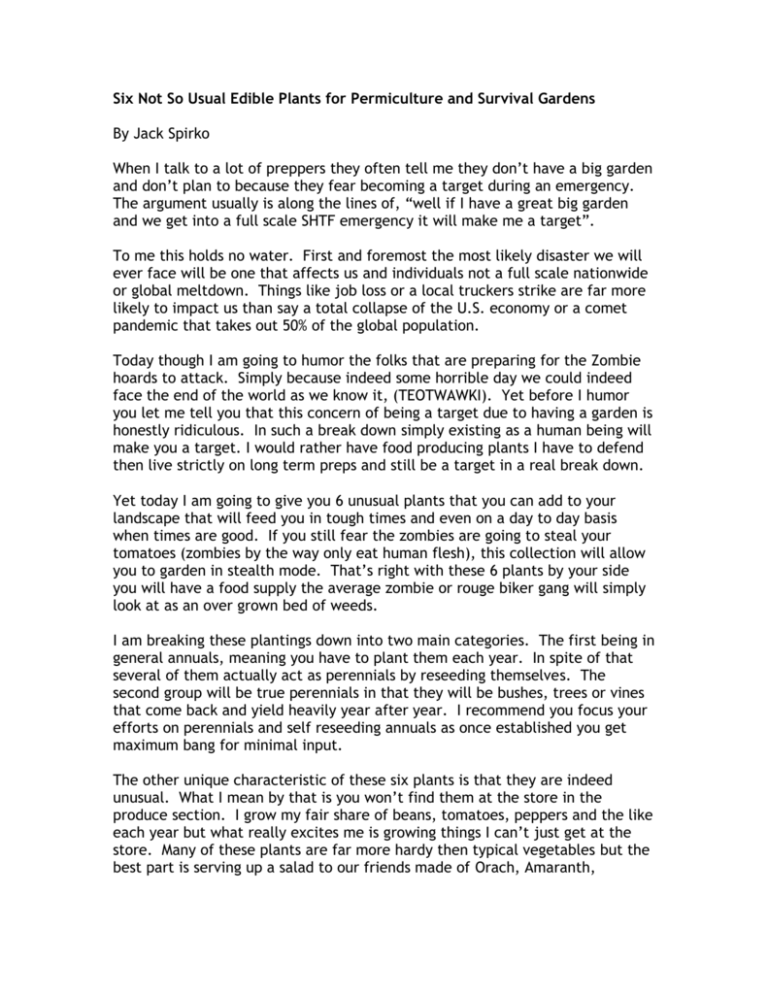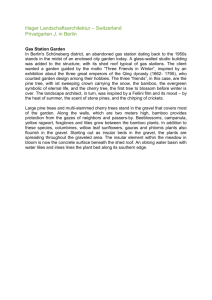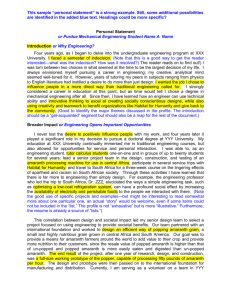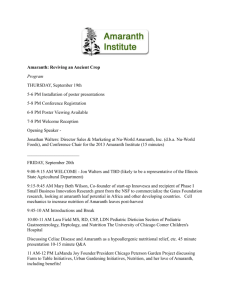Ten Not So Usual Edible Plants for Permiculture and Survival Gardens
advertisement

Six Not So Usual Edible Plants for Permiculture and Survival Gardens By Jack Spirko When I talk to a lot of preppers they often tell me they don’t have a big garden and don’t plan to because they fear becoming a target during an emergency. The argument usually is along the lines of, “well if I have a great big garden and we get into a full scale SHTF emergency it will make me a target”. To me this holds no water. First and foremost the most likely disaster we will ever face will be one that affects us and individuals not a full scale nationwide or global meltdown. Things like job loss or a local truckers strike are far more likely to impact us than say a total collapse of the U.S. economy or a comet pandemic that takes out 50% of the global population. Today though I am going to humor the folks that are preparing for the Zombie hoards to attack. Simply because indeed some horrible day we could indeed face the end of the world as we know it, (TEOTWAWKI). Yet before I humor you let me tell you that this concern of being a target due to having a garden is honestly ridiculous. In such a break down simply existing as a human being will make you a target. I would rather have food producing plants I have to defend then live strictly on long term preps and still be a target in a real break down. Yet today I am going to give you 6 unusual plants that you can add to your landscape that will feed you in tough times and even on a day to day basis when times are good. If you still fear the zombies are going to steal your tomatoes (zombies by the way only eat human flesh), this collection will allow you to garden in stealth mode. That’s right with these 6 plants by your side you will have a food supply the average zombie or rouge biker gang will simply look at as an over grown bed of weeds. I am breaking these plantings down into two main categories. The first being in general annuals, meaning you have to plant them each year. In spite of that several of them actually act as perennials by reseeding themselves. The second group will be true perennials in that they will be bushes, trees or vines that come back and yield heavily year after year. I recommend you focus your efforts on perennials and self reseeding annuals as once established you get maximum bang for minimal input. The other unique characteristic of these six plants is that they are indeed unusual. What I mean by that is you won’t find them at the store in the produce section. I grow my fair share of beans, tomatoes, peppers and the like each year but what really excites me is growing things I can’t just get at the store. Many of these plants are far more hardy then typical vegetables but the best part is serving up a salad to our friends made of Orach, Amaranth, Calendula and Huanzontle along side roasted venison with Bamboo shoots, Ground Nuts all topped with a sauce made from Nanking Bush Cherry. First up the annual crops, again these are crops that will have to be replanted or encouraged to reseed themselves each year. Unusual Annual One Huauzontle (pronounced “wah-zont-lay”) – This is an ancient crop that was a major Native American stable specifically in Central and South America. Huauzontle is often called “Red Aztec Spinach”. It is in a lot of ways like a cross between spinach and broccoli though much easier to grow in warm months then either, it however won’t tolerate frost like spinach or broccoli. Hence it makes a good substitute for both in warmer weather. Much like spinach the leaves can be eaten when young and tender in a salad and the entire plant along with the seed head can be braised and eaten as a cooked vegetable. Huauzontle is actually a relative to the common North American weed goosefoot and thrives across the entire nation during warm months. As it is not frost tolerant you should refrain from planting it outside until at least two weeks after your average last frost date. Unusual Annual Two Amaranth – There are over 60 species of wild and domesticated amaranth in the world and all are edible. Amaranth was a staple grain of all Native Americans from the most southern reaches of the United States well into the South American continent. I call Amaranth a wonder plant and when you hear all that it can do you will understand why. First the leaves of amaranth are extremely high in nutrition and can be used like spinach both cooked and raw. Next the seed heads are easily threshed and separated into grain which can be ground into gluten free flour. Ounce for ounce amaranth has more protein, fiber, good fats, carbohydrates, calicum and iron then wheat, corn, rice or oats. It is also much easier to grow for the average gardener then the typical staple grains. Sounds like a real winner but I am still not done, many varieties of amaranth grain can also be heated in a bit of oil and popped just like a micro version of pop corn. The leaves, gains and stems in surplus are also great feed for small live stock like chickens and rabbits. One plant that does this much is indeed a wonder plant. With all this going for it one may wonder why amaranth ever ceased being a stable grain. The answer lies in the actions of the religious missionaries who banned the natives from growing this plant. In the times when Europeans first settled in the Americas natives would mix amaranth grain with blood and honey to create effigies of animals which were eaten in religious ceremonies. This was to close to communion do one culture forced its views on another and a wonderful plant like amaranth went into obscurity of years. One has to wonder how much hunger could have been curtailed during colonial times with such an easy to grow nutritional plant had in not been banned in ignorance. Unusual Annual Three Orach – I chose to include Orach in this article because it has so many things going for it. First and foremost being how utterly easy it is to grow. The only thing you really need to know to be able to grow Orach is that it won’t handle anything beyond a light frost; a true freeze will generally kill it. It is a true survivor though and can readily reseed itself and will generally hold off on germination until danger has passed in most of the southern U.S. Orach is grown mostly as a “green” and used like lettuce, spinach or mustard greens. It is great as a salad green or cooked in soups, stews or braised with butter and garlic. Orach is a relative of lamb’s quarters which are largely used in the wild by outdoorsman as a wild edible. In addition to being tasty Orach is a nutritional dynamo, while far from calorically dense it is very high in vitamins, iron and other nutrients. The plant will grow up to and over 3 feet in height if allowed. Most often it is harvest when about 8-12 inches tall but you can simply harvest new leaves from the larger plants if you let them reach adulthood. The real beauty of Orach though lies in its color which is red to burgundy and has an iridescence that is really striking. The variety I grow in my garden is known as “Magenta Magic” and it truly lives up to its name. With such a visual appeal Orach is as at home among ornamental plantings as it is in the vegetable patch. The final beauty is buying one packet of seeds is all you will eve need to do. Last season I allowed one adult plant to go to seed and it produced hundreds of easily harvested seeds. Now on to three unusual perennials which will simply produce for you over and over, season after season with very little additional work. Overall I highly recommend you make perennials a main focus of your plantings because it will result in greater stability for your self sufficient food supply. Unusual Perennial One Nanking Bush Cherry – Unlike the other plants in this article I have not yet personally grown Nanking Bush Cherry as we have held on in plating them until we move to our new homestead this summer. The reasons for its inclusions are many. First and foremost unlike conventional cherries which don’t do will in many southern locations Nanking Bush Cherry will thrive from USDA Zone 3 to Zone 10, in other words almost the entire continental U.S. along with much of Canada and Mexico. Now what will get many eager homesteaders excited is how quickly you get into production with Nanking Bush Cherry. Unlike conventional cherries which will take 5 or more years to produce it is not unusual to get at least some production in year one and a bumper crop in year two with Nanking Bush Cherry. This plant can easily reach 8-10 feet but can also be pruned and maintained in the 5-6 food range making it a very versatile landscape plant. There are only two warnings with Nanking Bush Cherry. This first area of concern is birds eating all your cherries before you get any. Many birds seem relish Nanking Bush Cherry and netting may be necessary to preserve the crop for your own use. Of course since they are compact plants netting them is very easy to accomplish. Next is that Nanking Bush Cherry isn’t really a cherry, it isn’t exactly a plumb, it is actually somewhere between the two. While they taste like most slightly tart cherries they loose their stems when harvested and that leaves a tiny hole in them. Juice will leak from this hole and stain things. Hence they are best used quickly or preserved via freezing, in jellies or dehydrated very soon after harvest. One final thing, the home brewer will find they make one of the most amazingly tart and special cherry wheat beers that can be imagined. While I have never produced a wine or mead using Nanking Bush Cherry the potential seems to be there as well. Unusual Perennial Two Ground Nut – The Ground Nut is widely known by woodsmen in especially in the north eastern United States but it will grow well in most of the country. The big thing Ground Nut requires is patients if you want to harvest it year after year. The right way to establish a ground nut patch is to set up good fertile and well irrigated soil. Establish your plants and don’t start harvesting tubers until the third year, than harvest only 50% of the plants each season. If growing Ground Nut sounds like a lot of work it really isn’t, time does the work you just keep the area moist with irrigation. Once established the plot can produce year after year after year with growing yields. The rewards are many; Ground Nut is a highly nutritious plant in that it has 2 1/2 times the protein of an egg. There are only a few amino acids are lacking in the Ground Nut but milk has them so it is a great emergency protein source. Ground Nut is also a medicinal plant and can be used in small quantities prior to a meal to help control blood sugar. It has less starch than a potato but a similar though nutty flavor making it a great food for diabetics. It also curbs appetites far better then drug store diet pills and can even relieve diarrhea by supplementing nicotinic acid (Vitamin B3) deficiencies. Ground Nut is another wonder plant that can provide you with high quality nutrition for many years from a small well cared for patch. You can also harvest tubers at any time of year, which is really a big deal for the survival gardener. Unusual Perennial Three Clumping Bamboo – In America Bamboo is highly over looked as a productive plant. Many fear planting bamboo because it can really run amuck and spread rapidly. This can result it angry neighbors with destroyed lawnmowers once the rhizomes really get going. Yet this isn’t really a concern with “clumping” varieties of Bamboo because they spread slowly and evenly vs. via long runners. They other misconception is that Bamboo is a tropical plant that requires warm weather. Bamboo grows from the tropics into the mountainous regions of China and some verities are hardy to - 10°F or even lower. Clumping Bamboo doesn’t grow as large as its lager cousin but will often reach 12-16 feet in height and about ½ inch in diameter. Bamboo is strong and excellent building material. Think of a few clumps of Bamboo like having a ½ inch PVC pipe tree, providing you endless building material that is completely renewable. It also makes wonderful wind screens to block harsh winds and protect other plantings or small live stock. Last but certainly not least Clumping Bamboo like all Bamboos is edible. The shoots are delicious in stir fries and while expensive in stores an established clump or two will provide a family more shoots than they will most likely ever use. On top of all of this it also looks great in your landscape and the leaves can be fed to a variety of live stock. Rabbits seem to really enjoy a good chomp on some Bamboo leaf as do goats and cattle. So there you go 6 plants that provide food and other useful functions in your garden. Not to mention they want attract the zombie biker hoards when all hell breaks loose.










